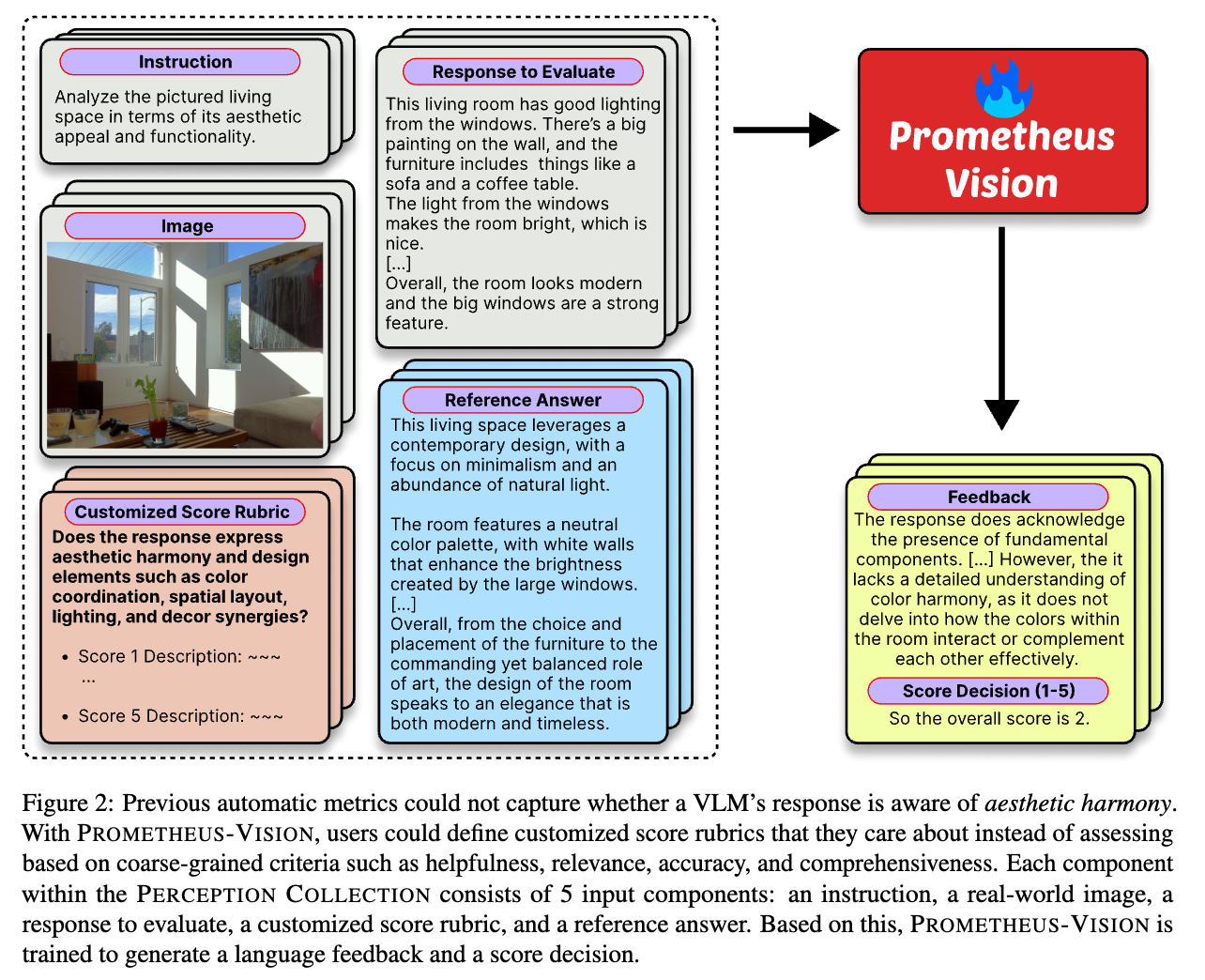Links for Reference
- Homepage: https://kaistai.github.io/prometheus-vision/
- Repository: https://github.com/kaistAI/prometheus-vision
- Paper: https://arxiv.org/abs/2401.06591
- Point of Contact: [email protected]
TL;DR
Prometheus-Vision is the first open-source VLM specialized for evaluation purposes. Prometheus-Vision shows a high correlation with both GPT-4V and human evaluators, indicating its potential to be used as a cheap alternative for GPT-4V evaluation.
 Prometheus-Vision have five input components (image, instruction, response to evaluate, customized score rubric, reference answer) and two output components (language feedback and score decision).
Prometheus-Vision have five input components (image, instruction, response to evaluate, customized score rubric, reference answer) and two output components (language feedback and score decision).

Model Details
Model Description
- Model type: Vision-Language Model
- Language(s) (NLP): English
- License: Apache 2.0
- Related Models: All Prometheus Checkpoints
- Resources for more information:
Prometheu-Vision is trained with two different sizes (7B and 13B). You could check the 13B sized VLM on this page. Also, check out our dataset as well on this page.
Prompt Format
Prometheus-Vision requires 5 components in the input: An image, an instruction, a response to evaluate, a score rubric, and a reference answer. You could refer to the prompt format below. You should fill in the instruction, response, reference answer, criteria description, and score description for score in range of 1 to 5.
###Task Description:
An instruction (might include an Input inside it), a response to evaluate, a reference answer that gets a score of 5, an image and a score rubric representing an evaluation criterion is given.
1. Write a detailed feedback that assess the quality of the response strictly based on the given score rubric, not evaluating in general.
2. After writing a feedback, write a score that is an integer between 1 and 5. You should refer to the score rubric.
3. The output format should look as follows: \"Feedback: (write a feedback for criteria) [RESULT] (an integer number between 1 and 5)\"
4. Please do not generate any other opening, closing, and explanations.
###The instruction to evaluate:
{instruction}
###Response to evaluate:
{response}
###Reference Answer (Score 5):
{reference_answer}
###Score Rubrics:
[{criteria_description}]
Score 1: {score1_description}
Score 2: {score2_description}
Score 3: {score3_description}
Score 4: {score4_description}
Score 5: {score5_description}
###Feedback:
License
Perception Collection and Prometheus-Vision are subject to OpenAI's Terms of Use for the generated data. If you suspect any violations, please reach out to us.
Usage
Find below some example scripts on how to use the model in transformers:
Using the Pytorch model
Running the model on a GPU
Click to expand
import argparse
import torch
import os
import json
from tqdm import tqdm
import shortuuid
from llava.constants import IMAGE_TOKEN_INDEX, DEFAULT_IMAGE_TOKEN, DEFAULT_IM_START_TOKEN, DEFAULT_IM_END_TOKEN
from llava.conversation import conv_templates, SeparatorStyle
from llava.model.builder import load_pretrained_model
from llava.utils import disable_torch_init
from llava.mm_utils import tokenizer_image_token, get_model_name_from_path, KeywordsStoppingCriteria
from PIL import Image
import math
def split_list(lst, n):
"""Split a list into n (roughly) equal-sized chunks"""
chunk_size = math.ceil(len(lst) / n) # integer division
return [lst[i:i+chunk_size] for i in range(0, len(lst), chunk_size)]
def get_chunk(lst, n, k):
chunks = split_list(lst, n)
return chunks[k]
def eval_model(args):
# Model
disable_torch_init()
model_path = 'kaist-ai/prometheus-vision-7b-v1.0'
model_name = 'llava-v1.5'
tokenizer, model, image_processor, context_len = load_pretrained_model(model_path, args.model_base, model_name)
questions = [json.loads(q) for q in open(os.path.expanduser(args.question_file), "r")]
questions = get_chunk(questions, args.num_chunks, args.chunk_idx)
answers_file = os.path.expanduser(args.answers_file)
os.makedirs(os.path.dirname(answers_file), exist_ok=True)
ans_file = open(answers_file, "w")
for line in tqdm(questions):
idx = line["question_id"]
image_file = line["image"]
qs = line["text"]
cur_prompt = qs
if model.config.mm_use_im_start_end:
qs = DEFAULT_IM_START_TOKEN + DEFAULT_IMAGE_TOKEN + DEFAULT_IM_END_TOKEN + '\n' + qs
else:
qs = DEFAULT_IMAGE_TOKEN + '\n' + qs
conv = conv_templates[args.conv_mode].copy()
conv.append_message(conv.roles[0], qs)
conv.append_message(conv.roles[1], None)
prompt = conv.get_prompt()
input_ids = tokenizer_image_token(prompt, tokenizer, IMAGE_TOKEN_INDEX, return_tensors='pt').unsqueeze(0).cuda()
image = Image.open(os.path.join(args.image_folder, image_file))
image_tensor = image_processor.preprocess(image, return_tensors='pt')['pixel_values'][0]
stop_str = conv.sep if conv.sep_style != SeparatorStyle.TWO else conv.sep2
keywords = [stop_str]
stopping_criteria = KeywordsStoppingCriteria(keywords, tokenizer, input_ids)
with torch.inference_mode():
output_ids = model.generate(
input_ids,
images=image_tensor.unsqueeze(0).half().cuda(),
do_sample=True if args.temperature > 0 else False,
temperature=args.temperature,
top_p=args.top_p,
num_beams=args.num_beams,
# no_repeat_ngram_size=3,
max_new_tokens=1024,
use_cache=True)
input_token_len = input_ids.shape[1]
n_diff_input_output = (input_ids != output_ids[:, :input_token_len]).sum().item()
if n_diff_input_output > 0:
print(f'[Warning] {n_diff_input_output} output_ids are not the same as the input_ids')
outputs = tokenizer.batch_decode(output_ids[:, input_token_len:], skip_special_tokens=True)[0]
outputs = outputs.strip()
if outputs.endswith(stop_str):
outputs = outputs[:-len(stop_str)]
outputs = outputs.strip()
ans_id = shortuuid.uuid()
ans_file.write(json.dumps({"question_id": idx,
"prompt": cur_prompt,
"text": outputs,
"answer_id": ans_id,
"model_id": model_name,
"metadata": {}}) + "\n")
ans_file.flush()
ans_file.close()
if __name__ == "__main__":
parser = argparse.ArgumentParser()
parser.add_argument("--model-path", type=str, default="facebook/opt-350m")
parser.add_argument("--model-base", type=str, default=None)
parser.add_argument("--image-folder", type=str, default="")
parser.add_argument("--question-file", type=str, default="tables/question.jsonl")
parser.add_argument("--answers-file", type=str, default="answer.jsonl")
parser.add_argument("--conv-mode", type=str, default="llava_v1")
parser.add_argument("--num-chunks", type=int, default=1)
parser.add_argument("--chunk-idx", type=int, default=0)
parser.add_argument("--temperature", type=float, default=0.2)
parser.add_argument("--top_p", type=float, default=None)
parser.add_argument("--num_beams", type=int, default=1)
args = parser.parse_args()
eval_model(args)
Citation
If you find the following model helpful, please consider citing our paper!
BibTeX:
@misc{lee2024prometheusvision,
title={Prometheus-Vision: Vision-Language Model as a Judge for Fine-Grained Evaluation},
author={Seongyun Lee and Seungone Kim and Sue Hyun Park and Geewook Kim and Minjoon Seo},
year={2024},
eprint={2401.06591},
archivePrefix={arXiv},
primaryClass={cs.CL}
}
- Downloads last month
- 43